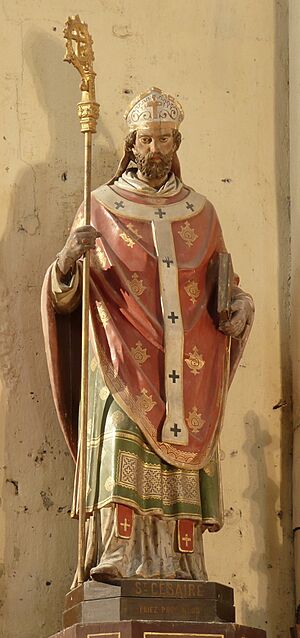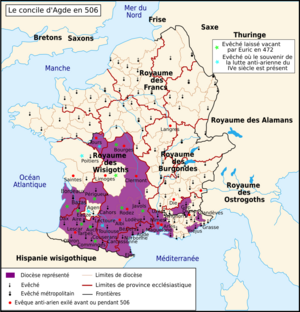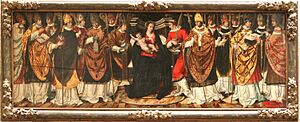Caesarius of Arles facts for kids
Quick facts for kids SaintCaesarius of Arles |
|
|---|---|

Statue of Caesarius of Arles in the Église Saint-Césaire d'Arles (Arles, France)
|
|
| Bishop and Church Father | |
| Born | 468/470 AD Chalon-sur-Saône, Western Roman Empire |
| Died | 27 August 542 AD |
| Venerated in | Roman Catholic Church Eastern Orthodox Church |
| Feast | August 27 |
Caesarius of Arles (Latin: Caesarius Arelatensis; 468/470 – 27 August 542 AD) was a very important church leader in his time. He lived in a region of France called Merovingian Gaul. People sometimes called him "of Chalon" because he was born in Chalon-sur-Saône.
Caesarius was one of the last church leaders in Gaul who tried to bring strict religious practices into Western Christian traditions. He was known as a "popular preacher" who inspired many people. Important thinkers like Augustine of Hippo, Julianus Pomerius, and John Cassian greatly influenced him.
Caesarius believed that bishops needed to do their job of guiding people very well. Preaching was already common in churches, but Caesarius was especially keen on it. He encouraged his clergy to preach often, both inside and outside the church. His sermons usually focused on how people should live good, moral lives.
Contents
The Life of Saint Caesarius
Caesarius was born in what is now Chalon-sur-Saône. This was during the final years of the Western Roman Empire. His parents were Roman-Burgundian. His sister, Caesaria the Elder, later led a convent that he started. He wrote a special guide for her called "Rule for Virgins."
When Caesarius was born, Germanic kings actually ruled Burgundy. This was even though the Romans were still technically in charge. Unlike his family, Caesarius felt a very strong connection to religion. This made him feel different from his family when he was growing up.
Becoming a Monk and Priest
At seventeen, Caesarius left home to study with Bishop Sylvester for a few years. After that, he went to Lérins. This was an island monastery famous for its strong religious community. He trained as a monk there. He wanted to improve Christian life and help the poor.
Caesarius quickly learned a lot at Lérins. He became the cellarer, which meant he managed the monastery's food. But he was very strict and sometimes held back food from monks he thought were not serious enough. Because of this, the abbot (leader) removed him from his job. Caesarius then started to starve himself. The abbot stepped in and sent him to Arles for medical care. After more than ten years at Lérins, his health was getting worse. So, Caesarius looked for a different religious community in Arles.
When he arrived in Arles, Caesarius was surprised to find that the bishop, Aeonius, was a relative from his hometown. Aeonius later made Caesarius a deacon and then a priest. For three years, Caesarius led a monastery in Arles.
Becoming Bishop of Arles
When Bishop Aeonius died, the people and church leaders chose Caesarius to be the new bishop. He was consecrated (officially made a bishop) in 502 AD, when he was about 33 years old. In his new role, he was brave and focused on his religious duties. He also showed great kindness.
Caesarius worked hard to get ordinary people to join church services. He encouraged them to ask questions about his sermons. He also told people to read the Holy Scripture at home. He wanted them to treat God's word with the same respect as the sacraments.
He was famous for caring for the poor and sick. He often paid to free prisoners and helped those in need. He was especially keen on freeing captives, even selling church decorations to do so.
Challenges and Influence
By middle age, Caesarius was a leading church leader and spiritual force. In 506 AD, he led the Council of Agde. This meeting, attended by 35 bishops, mainly discussed church rules.
As bishop, Caesarius lived in a time of many wars. Different kingdoms like the Visigothic, Ostrogothic, and Frankish were fighting for control of Southern Gaul. This meant Caesarius often had to ransom (pay to free) people caught in these wars. After a war in 507/508, many people were starving or in danger of being enslaved. Caesarius saved many people.
His actions were sometimes controversial. He ransomed not only his own people but also "barbarians" (enemies of the city). He explained that everyone was a human being. He believed everyone had the chance to enter God's kingdom.
Caesarius was once accused of trying to give Arles to the Burgundians. He was sent away to Bordeaux. But when his innocence was proven, he quickly returned. He even spoke up to save the life of the person who accused him. Later, when Arles was under attack, he was again accused and put in prison. But after meeting with the Ostrogothic king, Theodoric the Great, he was cleared. The rest of his time as bishop was peaceful.
Caesarius was well-liked in Rome. A book he wrote about grace and free will was approved by Pope Felix IV. The rules made at the Council of Orange were also approved by Pope Boniface II. Some historians believe he was the first Western bishop to receive a special scarf called a pall from the Pope.
Caesarius's Religious Beliefs
Caesarius was a strong follower of Augustine of Hippo. Augustine's writings deeply shaped Caesarius's ideas about community. Caesarius was also greatly influenced by his teacher, Julianus Pomerius. Pomerius believed that bishops and clergy should live more like monks, not like rich aristocrats. This meant avoiding fancy parties, large estates, and worldly learning. Instead, Pomerius urged them to give away their wealth and live simply.
Caesarius followed these teachings. He rejected worldly learning and comfortable living. He also organized his clergy to live in a monastic way.
Spreading Christian Ideas
Christianity spread slowly and unevenly in the early Middle Ages. It involved building churches and getting people to adopt Christian values. The church often fought against old superstitions and pagan practices. These were still common among ordinary people. But these changes only happened if local people agreed and took part.
Caesarius wrote two sets of rules for religious communities. One was for men ("Ad Monachos") and the other for women ("Ad Virgines"). The rule for monks was based on the traditions of Lérins.
As a preacher, Caesarius knew the Bible very well. His sermons were practical. He spoke out against common human faults. He also fought against old pagan practices, like fortune-telling. Several of his sermons have been published in books.
Writings and Teachings
Caesarius wrote over 250 sermons that we still have today. His sermons show that he was a pastor dedicated to training clergy. He also focused on teaching moral lessons to ordinary people. He preached about Christian beliefs and values. He spoke against mixing Christian ideas with pagan ones. He stressed living a Christian life, loving God and your neighbor, reading the Bible, and preparing for judgment.
Many of Caesarius's sermons and writings were influenced by Augustine. Caesarius often adapted the introductions and conclusions of other philosophers, especially Augustine. Many of his writings, including the popular Vita Caesarii (Life of Caesarius), were translated into French, German, Italian, and Spanish.
Caesarius believed his sermons should not be just for the clergy. He preached to bishops, abbots, priests, and monks. He also encouraged the clergy to read to themselves and others. He asked people who couldn't read to hire others to read to them after church. This way, they could learn divine lessons. Caesarius wanted people to read these lessons at church and at home, day and night, alone and with family.
He believed that a Christian who didn't share what they learned wasn't doing what God intended. He thought that God's word should be available to everyone. Caesarius believed that Christian people were God's new "chosen ones." He dreamed of bringing people from all over the world into a peaceful and loving Christian community. This idea was similar to Augustine's concept of the "Christian People."
Scholars have noted two important parts of Caesarius's work. First, he was a creative leader who helped resolve long-standing debates about grace and good deeds. This happened at the Council of Orange in 529 AD.
Council of Orange, 529
The most important local meeting Caesarius led was the Council of Orange in 529 AD. This council made important statements about God's grace and human free will. The council stated that after baptism, all baptized people can and should, with Christ's help, do what is needed for salvation. They must be willing to work faithfully.
The council also strongly rejected the idea that God chooses some people for evil. They said that in every good deed, God starts the work within us first. This happens without us earning it. They believed God inspires faith and love in us. These ideas were considered important for both church leaders and ordinary people. So, several important laymen (non-clergy) were invited to sign these rules.
The Council of Orange in 529 is known for changing the ideas about grace in southern Gaul. It favored a version of Augustine's teachings.
Caesarius's Sermons
The second important part of Caesarius's work was his sermons. He had over 250 sermons that survived. Caesarius worked to edit, shorten, and simplify his sermons. This made them more effective and easier to understand. About one-third of his sermons were simplified versions of older religious texts.
His works traveled throughout the Christian West. They spread his ideas about Christian love, the meaning of the Last Judgment, the rights of the poor, and the idea of Christianity. His writings were used by monks in Germany. They even appeared in Anglo-Saxon poetry and in the works of important thinkers like Thomas Aquinas.
Historians have noted that Caesarius's teachings were mostly consistent across all his sermons. Recurring themes included what monks should do in a monastery. He believed it was important to find Christian salvation within the safe walls of a monastery. Monks should help each other on this journey. Unlike some other monks, Caesarius did not believe in being alone to receive God's grace. Instead, he stressed that brothers should live together and set good examples for one another.
A Rule for Women
Caesarius's Regula virginum (512), or Rule for Virgins, was the first Western rule written just for women. In this text, Caesarius argued for claustration. This meant women should stay completely inside the monastery from the time they entered until they died.
Caesarius also created strict rules for women in monasteries. He set times for prayer and limited worldly luxuries like fine clothes. He also set standards for modesty and devotion. He called the virgins he wrote for "gems of the Church." He said they "evade the jaws of spiritual wolves" with God's help.
After returning from being exiled in Bordeaux, Caesarius built a monastery for women outside Arles. This monastery was for a group of religious women led by his sister, Caesaria. Most women entering the monastery likely came from wealthy families. The "Rule for Virgins" had strict rules against having servants or wearing luxurious clothes.
There had been no monastery for women in Arles before this. Caesarius wanted to give women an equal chance at a monastic life. He believed women in the monastery had a religious advantage. They were separated from the worries of daily city life. This allowed them to focus on a life of devotion.
Caesarius kept the monastery in his family until his death. Around 525 AD, he chose his niece, Caesaria the Younger, to take over from his sister.
Caesarius's Lasting Influence
As the leader of an important church area, the bishop of Arles had a lot of official and personal influence. Caesarius was generous in sharing his sermons. He sent ideas for talks to priests and bishops in Spain, Italy, and other parts of Gaul.
The main religious question of his time was about semi-Pelagianism. This was a debate about how much human effort and God's grace were needed for salvation. Caesarius, though a follower of Augustine, showed independent thinking on this. His strong disagreement with the idea that God chooses some people for evil caused different opinions about him later on.
Historians suggest that Caesarius may have had ideas similar to the later medieval concept of Christendom. His care for others, freeing captives, and building peace came from his basic belief in love. He believed God made it possible for everyone to show love. He even cared for the "barbarians" because he believed they were still part of God's plan and deserved help.
Historians say that Caesarius lived through a time of huge societal changes. He saw the beginning of these changes and tried to shape them. He helped to imagine the future forms of medieval Christendom. His ideas spread for a thousand years in the Western world.
Works by Caesarius
- Sermons, published in Latin and English.
- Rule for nuns, published in Latin and English.
- Rule for monks, published in Latin (not yet translated into English).
- Testament, published in Latin and English.
- Letters, translated into English.
See also
- Christianity in Gaul
- Christianity in the 6th century
Images for kids




